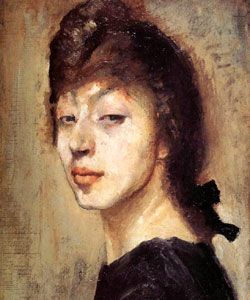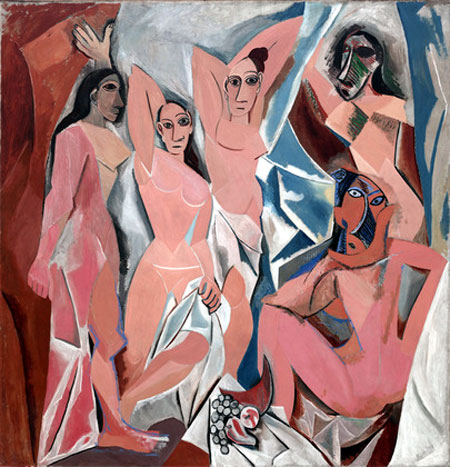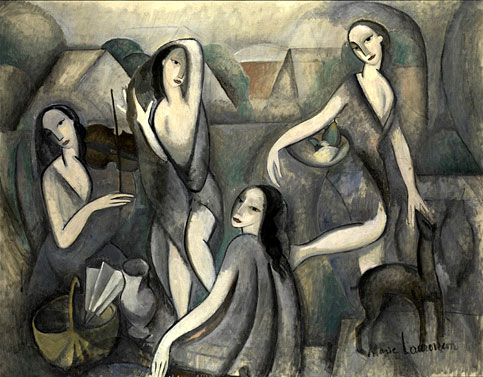|
 The Steiny Road Poet continues to look deeply into the work and life of the French artist Marie Laurencin, a life-long friend of Gertrude Stein and Alice B. Toklas. As with most women artists, today notwithstanding, the struggle to gain recognition required a certain gamesmanship. Most people who know anything about Twentieth Century art know Pablo Picasso's painting Les Demoiselles d'Avignon (1907). Less known is the painting that goaded Picasso to produce his masterpiece—Henri Matisse's Le Bonheur de Vivre (1906) and the painting taking inspiration from Les Demoiselles—Les Jeunes Filles (1910-1911) by Marie Laurencin. The Steiny Road Poet continues to look deeply into the work and life of the French artist Marie Laurencin, a life-long friend of Gertrude Stein and Alice B. Toklas. As with most women artists, today notwithstanding, the struggle to gain recognition required a certain gamesmanship. Most people who know anything about Twentieth Century art know Pablo Picasso's painting Les Demoiselles d'Avignon (1907). Less known is the painting that goaded Picasso to produce his masterpiece—Henri Matisse's Le Bonheur de Vivre (1906) and the painting taking inspiration from Les Demoiselles—Les Jeunes Filles (1910-1911) by Marie Laurencin.
BEFORE LES DEMOISELLES, LE BONHEUR
Gertrude and Leo Stein bought Matisse's Le Bonheur de Vivre (The Joy of Living) soon after it was painted and hung it prominently in their 27 rue de Fleurus apartment. The oil on canvas painting measuring 69 1/8 inches X 94 7/8 inches is a tempest of Fauve color (predominantly red, yellow, green) and odd perspective in which nudes dance, embrace, play musical instruments, and flaunt their sexuality in what might now be called an LSD landscape. Picasso, who was a frequent visitor to the apartment of the American sister-brother art collectors, grew so agitated over the prominence this painting enjoyed in the Stein collection that he vowed to best it.
In a very impertinent way, Picasso's Les Demoiselles d'Avignon debased Matisse's painting. While Matisse celebrated the flesh, Picasso denigrated it. Picasso's damsels are course, angular, and scary. Picasso planned to call his painting Le Bordel d'Avignon because his damsels were inspired by prostitutes. But his art critic friend André Salmon tromped Picasso and gave the painting the name by which it is known. Additionally, Picasso played with perspective in a way that completely redefined space. Picasso's Cubism was a style that Leo Stein disdained. Matisse called Les Demoiselles d'Avignon a hoax because, in his thinking, Picasso was trying to paint in the fourth dimension, an absolute impossibility.

When Gertrude and Leo split up in 1913, they also divided their art collection. Leo, who left 27 rue de Fleurus, took Le Bonheur de Vivre. Around 1924-25, Leo sold a number of paintings from his collection and it was probably at this time that Albert Barnes (of Philadelphia and the hard-to-access Barnes Collection) acquired Matisse's masterpiece. Because of negative criticism Barnes received from the art community, Barnes placed stringent rules on his collection, which allowed no lending and so sealed the fate of this spectacular work of art. Therefore Le Bonheur de Vivre was not well known.
LAURENCIN'S HARMONY, PICASSO'S DISCORD

Is Marie Laurencin's Les Jeune Filles a knockoff of Les Demoiselles d'Avignon? Les Jeune Filles clearly shows Cubist influence with its angular landscape behind the young women of the painting, one of whom has her arm behind her head in a way that draws attention similar to the way the eye is drawn to two of Picasso's demoiselles with upturned arms. Laurencin's women with their stylized noses seem to effect a mask-like face with all these faces being pretty much the same face. Picasso, under the influence of African art, painted two of his damsels with unambiguous masks though the other three hardly seem to have natural facial features with their excessively large eyes and noses and their tiny lipless mouths.
Both painters included a display of fruit but while Picasso's fruit serves to emphasis the distortion of his Cubist lines that disconnects the human figures from nature, Laurencin's use of fruit tucked into a bowl under the arm of young woman who is dancing emphasizes a harmony with nature. In fact, harmony is the prevailing mood of Laurencin's painting and, despite the Cubist backdrop, seems more in tune with the figures in Matisse's Le Bonheur de Vivre. Like Matisse's painting, Laurencin's has figures playing a musical instrument and dancing as well as the appearance of a tamed animal nuzzling the free hand of the fruit-carrying dancer.
THE INTENTION OF DIMENSION, COLOR, INNUENDO
Also similar to Matisse's intention, Laurencin's canvas, which measures 45 ÂĽ inches by 57 ½ inches, is meant as a landscape. Dimensionally, Picasso's painting with its squeezed width—Les Demoiselles d'Avignon measures 96 inches high by 92 inches wide—emphasizes portraiture. His portrait of five naked women makes it appear as if these women have torn through a set of theatrical curtains or might that be bed sheets hanging on some unseen clothesline with blue sky peeking through in angular pieces?
What particularly distinguishes Laurencin's painting from Picasso's and Matisse's is that Laurencin's women are clothed. While les jeunes filles show skin, there are no distinct details to show womanly body parts. Also the color palette for this Laurencin painting is a set of somber gray and brown tones with the flesh being a wan ash white. Laurencin's color palette stands in opposition to Picasso's flesh tones, some of which seem the color of burned skin.
The Steiny Road Poet wonders if Marie Laurencin ever heard Picasso joking about who the women were in Les Demoiselles d'Avignon. The story goes that he would point to three of these figures saying, there is the grandmother of Max Jacob (Jacob's grandmother was from Avignon), there is Fernande Olivier (his girl friend at the time of this painting), and there is Marie Laurencin. The insult of these real life women being twinned to Picasso's painterly prostitutes cannot be dismissed.
The Steiny Poet would not say Laurencin got the last laugh because her painting spent years in the private collection of Rolf de Maré, a Swedish art collector with a keen interest in dance, and then he gave the painting to Moderna Museet of Stockholm, Sweden. However, between 1908 and 1913, Laurencin painted a number of large-scale figurative works that were exhibited at the Salon des Indepéndants, the Salon d'Automne, the Salon de la Section d'Or, and the New York City Armory Show of 1913. Her first solo exhibition occurred in 1912 at the Galerie Barbazanges in Paris. Not a bad score for a femme peintre in the early days of the twentieth century.
|